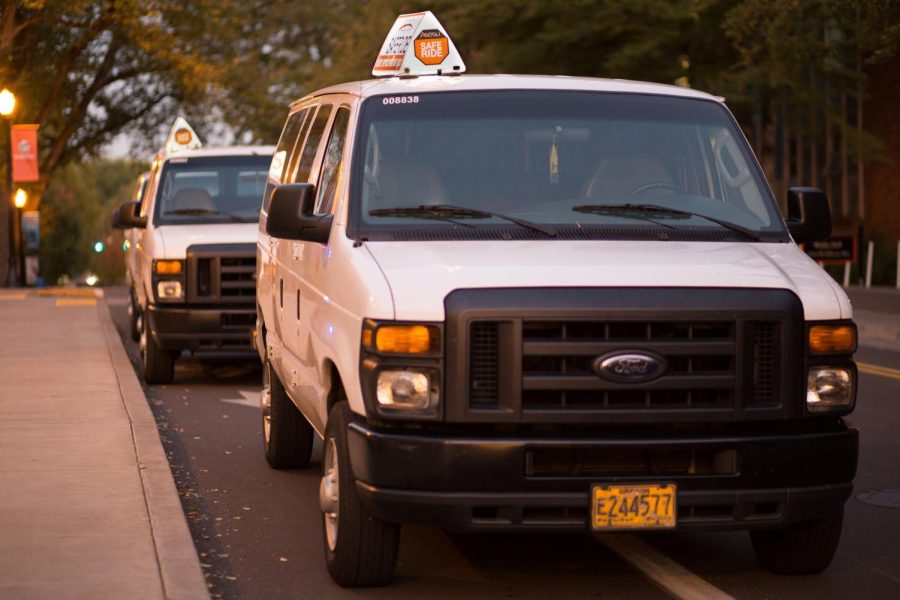ASOSU’s SafeRide transportation service aims to better serve students with disabilities
April 27, 2020
Since SafeRide, the Associated Students of Oregon State University’s transportation service, implemented a staff training in order to better serve students with disabilities, staff have gained hands-on experience, and community members said SafeRide is safer for it.
“Training sessions included hands-on experience using the ramp and wheelchair mounting straps in our wheelchair accessible van. The training was provided by me, as interim-SafeRide coordinator, and Uwe Keist, our student SafeRide manager,” said Drew Desilet, interim ASOSU SafeRide coordinator and advisor, in an email statement.
Desilet said the training implemented in winter term of 2020 ensured that SafeRide’s staff would be better prepared to serve the needs of students who use mobility aids, like wheelchairs or scooters.
“The trainings have provided additional time and first-hand experience utilizing our wheelchair accessible van, ramp and safety straps,” Desilet said over email.
According to Desilet, SafeRide decided to implement these updated trainings after receiving feedback from a student rider who said that the staff member who was driving the wheelchair-accessible van didn’t know how to use the security straps put in place for wheelchair users.
Kobey Bonin, a fourth-year liberal studies student at OSU, was one of the riders who had difficulties using SafeRide.
“Before the SafeRide training, I had a pretty problematic experience where the tie-down straps were not properly secured. My girlfriend, who was traveling with me, had to physically restrain my wheelchair herself, and I felt very unsafe,” Bonin said.
According to Bonin, before the training, experiences like his were relatively common, and he said he felt that SafeRide has had a history of accessibility issues. Additionally, he said that he’d had difficulty communicating with the SafeRide staff.
“In my experience with attempting to communicate with SafeRide, I found it to be very difficult to contact anybody in their office. I sent a number of emails, left a number of voicemail messages and even visited the office four or five times. During that time I didn’t receive a single acknowledgment my message had been received. I did ultimately receive a reply, but it was just a notification of the changes,” Bonin said.
Bonin said he felt that the trainings have made SafeRide safer, and have decreased stress involved with using the transportation service, but that he hopes they continue to improve.
Earlee Kerekes-Mishra, assistant director for the Disability Access Services at OSU, said she hadn’t personally heard of any students coming to the DAS about accessibility issues with SafeRide, but she approved of ASOSU taking the initiative to educate their staff.
“Any training is good training. I think ASOSU stepping out and saying, ‘wow, you know, we have students that are wheelchair users, and we want to make sure that we’re serving our peers in the best way possible,’” Kerekes-Mishra said. “I commend ASOSU for recognizing that training needs to be done, and doing it.”
Kerekes-Mishra also said that language used to refer to people with disabilities is constantly evolving and that no one-time training could permanently create an accessible program.
“Is there always room for improvement? Yes. We need to continually look to see if we need to change,” Kerekes-Mishra said.
Due to the COVID-19 pandemic, SafeRide is not in operation during spring term, to promote student safety.
In a written statement on the publicStudent Fee Services Canvas page, SafeRide stated, “We are supporting the student staff of our program, keeping them employed and focused on operational and system updates and improvements within ASOSU SafeRide, in preparations for fall term.”
The student body can learn when SafeRide will reopen from the public ASOSU website or all- student email lists.




















































































![Newspaper clipping from February 25, 1970 in the Daily Barometer showing an article written by Bob Allen, past Barometer Editor. This article was written to spotlight both the student body’s lack of participation with student government at the time in conjunction with their class representatives response. [It’s important to note ASOSU was not structured identically to today’s standards, likely having a president on behalf of each class work together as one entity as opposed to one president representing all classes.]](https://dailybaro.orangemedianetwork.com/wp-content/uploads/2025/03/Screenshot-2025-03-12-1.00.42-PM-e1741811160853.png)























